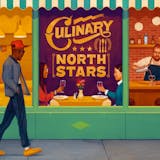The world’s largest island has always seemed oh-so-remote. Snuggled between the North Atlantic and Arctic oceans, Greenland is intimately linked with adventurous outdoor experiences, whether it’s gazing at otherworldly aurora borealis, mushing a team of sled dogs or sea kayaking in iceberg-studded fjords.
Recently, the country is also making global headlines not as buzzing tourist destination or for its melting glaciers, but because President Donald Trump has set his sights on acquiring it. That’s curious, given that Greenland is a former Danish colony and now a self-governing, autonomous country within the Kingdom of Denmark.
Whether this geopolitical drama makes Greenland more or less attractive as a destination, one thing is for certain: It’s no longer quite so remote. The international airport in Nuuk, the world’s northernmost capital, recently expanded its runway, allowing larger aircraft to land there.
Starting March 30, Icelandair will easily connect Minneapolis-St. Paul and its other U.S. gateways with Nuuk via a short layover or extended stopover in Reykjavik. And in June, United Airlines will connect Newark to Nuuk twice a week, potentially making the trip even shorter.
Many seasoned travelers might skip an extended visit to the city proper in favor of more far-afield activities. As an artist and designer, I was more keen on soaking up the creative energy of this wee capital city of about 20,000 people, or 39% of the population. Nuuk bubbles with an inventiveness that’s interlaced with the Inuit culture — Inuit people make up most of the population.
Hemmed in by jagged peaks and the vast Labrador Sea, this scenic city is a wonderful dichotomy of modern and traditional. Traveling from the airport to the Hotel Hans Egede, I marveled at the striking colors bursting from Nuuk’s windswept, grey stone-laden landscape, thanks to the clusters of traditional timber houses painted in a rainbow of vivid hues: azure, crimson, lemon yellow and orchid. I knew then my visit to Nuuk would be eye-opening.
Artistic endeavors
Housed partly in a sea-green former church that still bears a soaring spire is the Nuuk Art Museum. The sunny interior holds over 1,000 mostly 20th-century paintings and sculptures by local and international artists, focused on the culture and landscape of Greenland. Works include more than a dozen lithographs of Mount Sermitsiaq — a nearly 4,000-foot-tall landmark hovering over Nuuk — created by Inuit artist Anne-Birthe Hove. She shows the mountain in an array of hues and its many personalities, whether cloaked in clouds or draped with snow. Another noteworthy piece is Kistat Lund’s brilliantly hued triptych painting depicting sky, mountain, fjord and plains in all their Greenlandic glory.
Continue your explorations on a self-guided public art walk. (Download a PDF guide or listen to their audio guide.) The 18 murals and sculptures on the route offer insights into Greenland’s heritage. One end of a nondescript concrete apartment complex is plastered with the portrait of an old Inuit hunter from East Greenland. Ten minutes away is another unremarkable building, except for the series of rectangular tiles, each painted with a large raven. Look quickly from one to the next and the bird appears to be flying.



